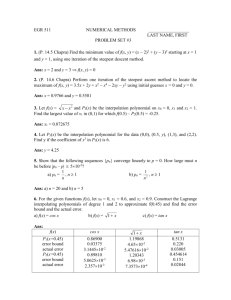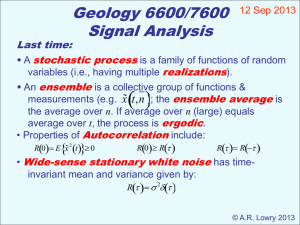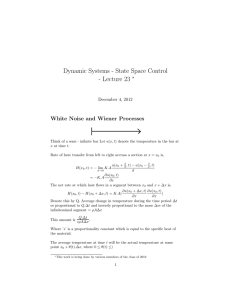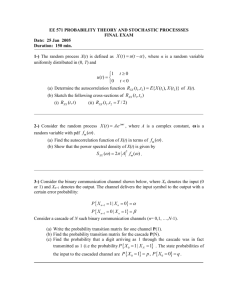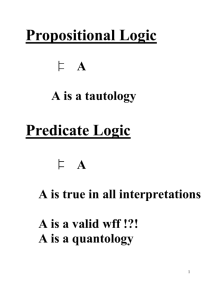Digital Signal Prossessing I part03
advertisement
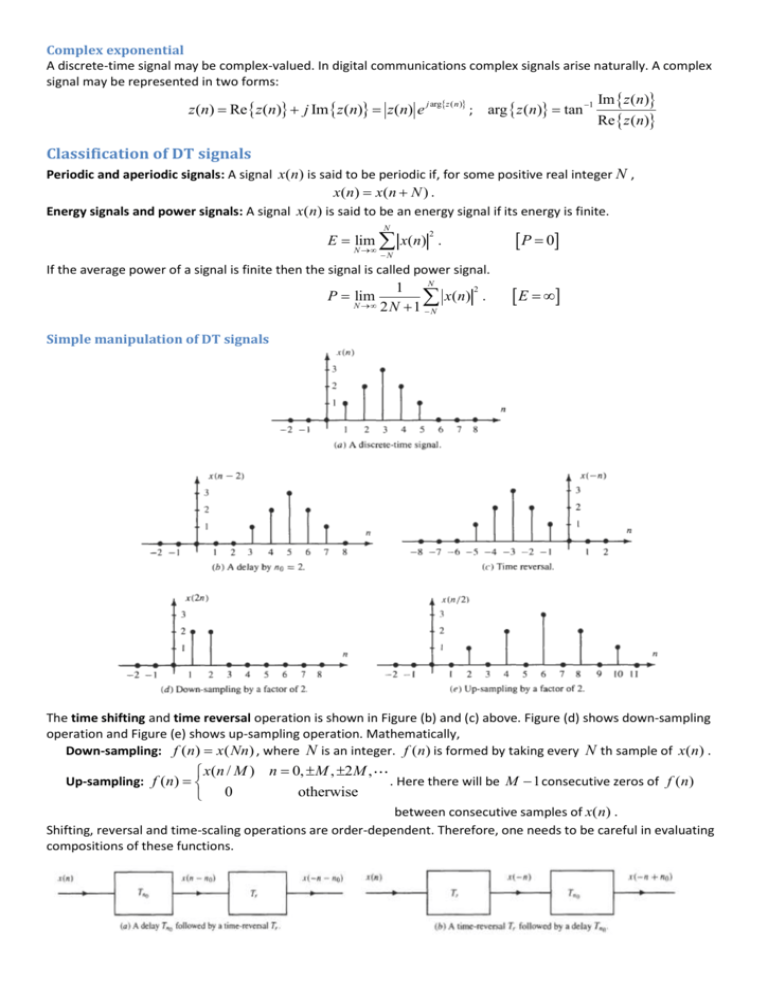
Complex exponential
A discrete-time signal may be complex-valued. In digital communications complex signals arise naturally. A complex
signal may be represented in two forms:
z (n) Re z (n) j Im z (n) z (n) e j argz ( n ) ; arg z (n) tan 1
Im z (n)
Re z (n)
Classification of DT signals
Periodic and aperiodic signals: A signal x(n) is said to be periodic if, for some positive real integer N ,
x ( n) x ( n N ) .
Energy signals and power signals: A signal x(n) is said to be an energy signal if its energy is finite.
N
E lim x(n) .
N
2
N
P 0
If the average power of a signal is finite then the signal is called power signal.
N
1
2
x ( n) .
N 2 N 1
N
P lim
E
Simple manipulation of DT signals
The time shifting and time reversal operation is shown in Figure (b) and (c) above. Figure (d) shows down-sampling
operation and Figure (e) shows up-sampling operation. Mathematically,
Down-sampling: f (n) x( Nn) , where N is an integer. f ( n) is formed by taking every N th sample of x(n) .
x(n / M ) n 0, M , 2M ,
otherwise
0
Up-sampling: f (n)
. Here there will be M 1 consecutive zeros of f ( n)
between consecutive samples of x(n) .
Shifting, reversal and time-scaling operations are order-dependent. Therefore, one needs to be careful in evaluating
compositions of these functions.
Analysis of DT systems
T
x(n)
y(n)
T is used to represent a general system. The input signal x(n) is transformed into an output signal y (n) through
the transformation T .
Classification of systems
1. Linear system:
T
T
y1 (n) and x2 (n)
y2 (n) then for a linear system,
If x1 (n)
T
a1 x1 (n) a2 x2 (n)
a1 y1 (n) a2 y2 (n) .
2. Time-invariant system:
T
T
y (n n0 ) .
If x(n)
y(n) then for a time-invariant system, x(n n0 )
3. BIBO stable system:
A system is BIBO stable if and only if whenever the input signal is bounded as x(n) A for all n, the output is also
bounded as y(n) B for all n. If this is violated by the input-output pair the system is not stable.
4. Causal system:
A system is causal if the output y (n) at any time is independent on any value of x ( n m) for m 0 .
5. Mamoryless system:
A system is said to be memoryless if the output at any time n n0 depends only on the input at time n n0 .
6. Invertible system:
A system is said to be invertible if the input to the system may be uniquely determined from the output.
Example
j
n
cos( n) and ii) x(n) cos(0.125 n) .
17
j N
j n
n N
i) x(n N ) e 16 e 16 cos
; For periodicity, 16 N 2 k1 and 17 N 2 k2 .
17 17
k 17
N 32k1 34k2 1 ; For k1 17 , N 32 17 544
[Ans]
k2 16
A. Determine the periodicity of the signals, i) x(n) e
16
So, the period of the signal is, 544.
ii) N 2
k
16k . Therefore, N 16.
0.125
B. Find the even and odd part of the signal x(n) nu (n) . Hints: xe (n)
[Ans]
1
x(n) x(n) , etc.
2
n
C. Is the system y (n) x(n) sin
2
linear?
T
T
y1 (n) and x2 (n)
y2 (n) . Then for x(n) a1 x1 (n) a2 x2 (n) ,
Let, x1 (n)
y (n) a1 x1 (n) a2 x2 (n) sin
n
2
a1 x1 (n) sin
n
2
a2 x2 (n) sin
n
2
a1 y1 (n) a2 y2 (n) .
As the linearity property holds, the system is linear.
D. Is the system y(n) x(n) x(n2 n) causal?
For n = -1, y (1) x(1) x(2) . As y (n) depends on the future value of x(n) , the system is noncausal.
E. Is the system y(n) e x ( n ) / x(n 1) stable?
Let x(n) (n) . Thus, y (n) . Thus the system is not stable.
F. Is the system y (n) x(n) x(n 1) invertible?
Let, x(n) x1 (n) . Then, y (n) x1 (n) x1 (n 1) .
Again let, x(n) x1 (n) C . Then, y (n) x1 (n) x1 (n 1) .
In both cases the output is the same. Hence, the system is not invertible.
G. Is the system y (n) 2nx(n) time-invariant?
T
y1 (n) and x1 (n) x(n n0 ) . Then, y1 (n) 2nx1 (n) 2nx(n n0 ) .
Let, x1 (n)
If the system is time-invariant, y(n n0 ) 2(n n0 ) x1 (n n0 ) .
Here, y1 (n) y (n n0 ) . Hence the system is time-variant.
[Ans]
Response of LTI systems to arbitrary inputs: The convolution sum
We denote the response of a system to unit sample sequence as impulse response, h(n).
h(n) T [ (n)]
For a time-invariant system, h(n k ) T [ (n k )] .
y (n) T [ x(n)] = T [ x(k ) (n k )]
Now,
k
y ( n)
x(k )T [ (n k )]
k
k
k
x ( k ) h( n k ) x ( n ) h ( n ) h ( n ) x ( n ) h ( k ) x ( n k )
The above operation is called convolution operation.
Steps to perform convolution:
1. Change the variable from n to k: x(n), h(n) x (k ), h(k ) .
2. Perform the folding operation: h(k ) h(k ) .
y (n0 )
3. Perform the shifting operation: h(k ) h(n0 k ) .
4. Multiplication: x(k )h(n0 k ) vn0 (k ) .
5. Summation: y(n0 )
v
n0
x ( k ) h( n
k
0
k)
(k ) .
Example
1. If x(n)=u(n) and h(n) = 0.8nu(n), y(n)=? .
y ( n)
k
n
0.8k u (k ) u (n k ) 0.8k
k 0
1 0.8n 1
; n0
1 0.8
[Ans]
2. x( n) {1, 2,3,1} , h( n) {1, 2,1, 1} , y ( n) ? .
x(k ) {1, 2,3,1}, h(k ) {1, 2,1, 1} ;
h(k ) {1,1, 2,1}
Lower limit of y (n) is 0-1=-1 and the upper limit is 3+2=5.
T
1* 1*
2 0
Now, y (1) 1 ;
3 0
1 0
T
T
1* 2*
1* 1*
2 1
2 2
y (0)
2 2 4 ; y (1) 1 4 3 8
3 0
3 1
1 0
1 0
T
T
T
1* 1*
1* 0*
1* 0*
2 1
2 1
2 0
y (2)
1 2 6 1 8 ; y (3)
3 ; y (4) 2
3 2
3 1
3 1
1 1
1 2
1 1
Similarly, y (5) 1 ; y (6) 0 .
Thus, y (n) {1, 4,8,8,3, 2, 1}
[Ans]
3. Sketch y (n) x(2n 3), and y (n) x(8 3n) for x(n) (6 n)[u (n) u (n 6)] .
Properties of convolution
1. Commutative property: x(n) h(n) h(n) x(n)
2. Associative property: {x(n) h1 (n)} h2 (n) x(n) {h1 (n) h2 (n)}
3. Distributive property: x(n) {h1 (n)} h2 (n)} x(n) h1 (n) x(n) h2 (n)
# x(n) (n) x(n) and x(n) (n k ) x(n k ) . # if x(n) N1 , h(n) N 2 , then, y(n) N1 N 2 1 .
For causal system and causal input the convolution sum becomes, y (n)
Some common series
n
n
k 0
k 0
x ( k ) h( n k ) h ( k ) x ( n k ) .
Stability of LTI systems
y ( n)
h(k ) x(n k ) ; Let, x(n) A , then, y (n)
h(k ) x(n k ) A
k
k
Therefore, the output y(n) is always bounded if
h(k ) is always bounded.
k
Example: h(n) a nu (n) . S
k
h( k ) a
k
k 0
1
; a 1.
1 a
The sum is finite for a 1 . Hence, the system is stable.
System described by difference equations
Let, a system has h(n) nu (n) . Therefore the response of the system would be,
y ( n)
k
h( k ) x ( n k ) k x ( n k )
y (n 1) k x(n 1 k )
k 0
The first equation may be written as, y (n) x(n)
k 0
k
x(n k ) .
k 1
Putting k=p+1, y(n) x(n)
p 0
p 0
p1x(n p 1) x(n) p x(n p 1) x(n) y(n 1)
y (n) x(n) y (n 1) .
i.e.,
The above equation is called linear constant coefficient difference equation.
The general form of LCCDE is,
M
N
k 0
k 1
y ( n) b( k ) x ( n k ) a ( k ) y ( n k )
(01)
where, the coefficients a(k) and b(k) are constants that define the system. if, all a(k ) s are not zero the system is
recursive. If a(k)=0 the system is non-recursive.
The integer N is called the order of the difference equation or the order of the system.
Difference equations provide a way for computing the response of a system, y(n) to an arbitrary input x(n). It is
necessary to satisfy a set of initial conditions to solve the above equation. For example, if x(n) begins at n=0, the
solution at time n=0 depends on the values of y (1), y (2), , y ( p ) . When the initial conditions are zero, the
system is said to be in initial rest.
The general solution of an LCCDE system is given as, y (n) yh (n) y p ( n)
(02)
The homogeneous solution, yh (n) is the response of the system to the initial conditions assuming that the input
x(n) 0 . The particular solution is the response of the system to the input x(n) , assuming zero initial conditions.
The homogeneous solution may be found by assuming a solution of the form,
yh ( n ) z n
(03)
Substituting in the general equation, z n
N
a (k ) z
nk
0
k 1
N
Or,
z n N [ z N a (k ) z N k ] 0 , z N a(1) z N 1 a(2) z N 2
a( N ) 0
k 1
The polynomial in equation (04) is called the characteristic polynomial. It has N roots.
If all the roots are distinct the homogeneous solution will be of the form,
yh (n) A1 z1n A2 z2n
AN z Nn
If there are m repeated roots, the solution would be,
yh (n) ( A11 A12 n
A1m n m 1 ) z1n A2 z2n
AN z Nn
If there are two complex roots, z1 , z2 a jb re j , the solution would be,
yh (n) r n ( B1 cos n B2 cos n ) A3 z3n
AN z Nn
(04)
Example:
1. Find yh (n) for the system, y (n) y (n 1) y (n 2) .
The characteristic polynomial, z 2 z 1 0
n
z
1 5
.
2
n
1 5
1 5
Hence, yh (n) A1
A
; n 0
2
2
2
Let the initial conditions be y (0) 0, y (1) 1 . Applying initial conditions,
1 5
1 5
A1
A2
1
2
2
n
n
1 1 5 1 5
yh ( n )
5 2 2
2. Find yh (n) for the system, y (n) 4 y (n 1) 4 y (n 2) 0
A1 A2 0;
The characteristic polynomial, z 2 4 z 4 0;
A1 A2
1
5
[Ans]
z1 , z2 2, 2
yh (n) ( A11 A12 n)2n
[Ans]
3. Find yh (n) for the system, y (n) 2 y (n 1) 2 y (n 2) 0
z1 , z2 1 j1 2e j 3 / 4
The characteristic polynomial, z 2 2 z 2 0;
yh ( n )
2 [ A cos 34n A sin 34n ]
n
1
[Ans]
2
--------------------------------------------------------------------------------------------------------------------For the particular solution it is necessary to find the sequence y p (n) that satisfies the difference equation for the
given x(n) . Table below lists particular solutions for some common inputs.
Example:
1. Find the solution of the difference equation,
y (n) 0.25 y (n 2) x(n)
for x(n) u ( n) with y (1) 1 and y (2) 0 .
y p (n) C1 . Substituting this in the difference equation we get,
For x(n) u ( n) ,
y p (n) 0.25 y p (n 2) 1 ,
C1 0.25C1 1 ; C1 4 / 3
or,
Now, the characteristic polynomial is, z 2 0.25 0
yh (n) A1 (0.5) A2 (0.5)
n
(01)
z 0.5
n
The total solution is, y (n) A1 (0.5) n A2 (0.5) n 4 / 3;
n0
(02)
The total solution only applies to n 0 , therefore, we have to derive an equivalent set of initial conditions
and y (1) from the system equation (01).
y (0) 0.25 y(2) x(0) 0.25 0 1 1
y (1) 0.25 y (1) x(1) 0.25 1 1 1.25
Using equation (02), 1 A1 A2 4 / 3; 1.25 0.5 A1 0.5 A2 4 / 3
y(n) 0.25(0.5) (1/12)(0.5) 4 / 3; n 0
n
n
A1 0.25, A2 1/12
[Ans]
y (0)
2. Find the response of the system y (n) y (n 1) y (n 2) 0.5 x(n) 0.5 x(n 1) to the input x(n) 0.5n u (n)
with initial condition y (1) 0.75 and y (2) 0.25 .
z 0.5(1 j 3) e j / 3 .
The characteristic equation of the system is, z 2 z 1 0 .
Thus,
yh (n) A1e j n / 3 A2 e j n / 3
And,
y p (n) C1 0.5n u(n); n 0
Substituting this in the difference equation we get, C1 0.5n C1 0.5n 1 C1 0.5n 2 0.5 0.5n 0.5 0.5n 1
C1 0.5
C1 2C1 4C1 0.5 1 ;
Therefore,
y (n) A1e
j n / 3
A2e
j n / 3
0.5 0.5 ; n 0
n
y(0) y(1) y(2) 0.5 x(0) 0.5 x(1) A1 A2 0.5 1
Applying initial conditions,
1
e j / 3
j / 3
j / 3
0.25 1
y(1) y(0) y(1) 0.5 x(1) 0.5 x(0) A1e A2e
1 j / 3
e
3/ 4
1 A1 0.5
A1
j 2
j / 3
e
3 1 j / 3
A2
A2 0.75
e
3 / 4
2
This yields, y (n) 0.5n 1
3
n
(n 1)
sin
3 sin
2
3
3
3. Find unit sample response, h(n) of the system described as y (n)
[Ans]
3
1
y (n 1) y (n 2) x(n) x(n 1) .
4
8
The impulse response is the response of a system with x(n) (n) and initial rest conditions.
The characteristic equation is, z 2
n
3
1
z 0
4
8
1
1
( z )( z )
2
4
1 1
z , .
2 4
n
1
1
Hence,
y (n) A1 A2 0; n 0
2
4
With initial rest condition, y (1) y (2) 0 , it follows that,
3
1
y
(0)
y
(
1)
y (2) x(0) x(1) 1 A1 A2
4
8
A1 2, A2 3
3
1
3
1
1
1
y (1) y (0) y (1) x(1) x(0) 1 A A
1
2
4
8
4
4 2
4
n
n
n
1 n
1
1
1
Hence, h(n) 2 3 ; n 0 , or, h(n) 2 3 u (n)
[Ans]
2
4
4
2
4. Find the response of the system of problem -3 for the input x(n) u (n) u (n 10) with zero initial condition.
Let, s ( n) be the step response of the system. Then, y (n) s (n) s (n 10) .
k
k
n
n
1
1
s (n) h(n) u (n) h(k ) 2 3
Now,
n0
2
4
k 0
k 0
n 1
n 1
1 (1/ 2)
1 (1/ 4)
n
n
s(n) 2
3
Or,
u (n) 2(1/ 2) (1/ 4) u(n)
1
1/
2
1
1/
4
Thus,
y (n) 2(1/ 2) n (1/ 4) n u (n) 2(1/ 2) n 10 (1/ 4) n 10 u ( n 10)
[Ans]
5. Find h(n) of the system described as: y (n) 3 y (n 1) 2 y (n 2) x(n) 3 x(n 1) 2 x(n 2) .
h(n) 3h(n 1) 2h(n 2) (n) 3 (n 1) 2 (n 2)
z 2 3z 2 0;
z1 , z2 1, 2
h(n) C1 C2 2 u (n) C3 (n)
n
Now, from the difference equation, h(0)=1; h(1)=3+3=6, h(2)=18-2+2=18
(01)
Putting these in equation (01) we get,
1 C1 C2 C3
6 C1 2C2
18 C 4C
1
2
C1 6, C2 6, C3 1
h(n) 6 6 2n u ( n) ( n) 6 2 n 1 u ( n) ( n)
[Ans]
6. Determine the response y (n) , n 0 , of the system described by the second –order difference equation
y (n) 3 y (n 1) 4 y (n 2) x(n) 2 x(n 1) when the input sequence is x(n) 4n u (n) .
Here, Ch. Eq.: z 2 3 z 4 0 ( z 1)( z 4) 0
Therefore,
z1 , z2 1, 4 .
yh (n) c1 (1) c2 (4) .
n
n
As the system root contains one characteristic root, y p (n) c3n(4)n . Putting this in system equation we get,
c3n(4) n u (n) 3c3 (n 1)(4) n 1 u (n 1) 4c3 (n 2)(4) n 2 u (n 2) (4) n u (n) 2(4) n 1 u (n 1)
For n 2 none of the unit step terms vanish. We can solve c3 for any n 2 . Use n=2
32c3 12c3 24 c3
6
.
5
Thus, the total solution of the difference equation is, y (n) c1 (1) n c2 (4) n
Assume that the initial conditions, y (1) y (2) 0 .
6
n 4n .
5
y (0) c1 c2 3 y (1) 4 y ( 2) 1 1
1
26
c1 , and c2
Then,
24
25
25
y (1) c1 4c2 5 3 y (0) 4 y ( 1) 6 9
1
26
6
(1) n (4) n n(4) n ; n 0
Hence, the zero-state response of the system is, y (n)
25
25
5
[Ans]
Correlation of D.T. signals
The correlation of two sequences is an operation defined by the relation,
rxy (l )
ryx (l )
x(k ) y (k l )
x (k l ) y (k )
k
k
k
k
y (k ) x(k l ) y (k l ) x (k )
rxy (l ) ryx (l )
The computation of correlation sequence involves the same operation as convolution except for the folding
rxy (l ) x(l ) y (l ) .
operation,
If y (n) x(n) , we have autocorrelation: rxx (l )
x(k ) x(k l ) .
k
If x(n) and y (n) are causal sequences of length N, (0 n N 1) ,then,
N p 1
rxy (l )
x(k ) y (k l ) , where,
for l 0 , i l & p 0 and for l 0 , i 0 & p l .
k i
Applications:
Correlation measures the degree to which two signals are similar. This concept is often used in radar, sonar and
digital communication.
1. Let, x(n) is the transmitted signal. y (n) is the received signal which is the delayed version of the input
signal. Then, y (n) x(n l ) w(n) . Correlation of x(n) and y (n) will be maximum at lag l from where
we can measure the distance of a target.
2. In communication system the concept of correlation is used to determine whether the received signal is
zero or one.
To transmit zero we send x0 ( n) , 0 n L 1 ;
To transmit one we send x1 (n) , 0 n L 1
Signal received by the receiver is, y(n) xi (n) w(n); i 0,1 . The receiver compares y (n) with
x0 (n) and x1 (n) {pattern available in receiver} to determine the signal that better match y (n) .
Example: Determine the correlation between the two sequences x(n) and y (n) given below.
x(n) {2, 1,3, 7,1, 2, 3, 7,1, 2, 3}
y(n) {1, 1, 2, 2, 4,1, 2,5}
Properties of correlation sequences
Let, x(n) and y (n) are two finite energy sequences. Now, the energy of the combined sequence, ax(n) y (n l ) :
E
ax(n) y(n l )
n
2
a 2 rxx (0) ryy (0) 2arxy (l ) 0
rxx (0) rxy (l ) a
0 for any finite value of a .
rxy (l ) ryy (0) 1
This equation can be rewritten as: a 1
rxx (0) rxy (l )
is positive semi-definite.
r
(
l
)
r
(0)
xy
yy
Thus, the matrix
This implies, rxx (0)ryy (0) rxy2 (l ) 0 ,
For, y (n) x(n) ,
i.e., rxy (l ) rxx (0)ryy (0)
Ex E y .
rxx (l ) Ex .
Thus autocorrelation attains its maximum value at zero lag.
Quadratic Forms
A quadratic form ‘q’ in ‘n’ variables x1 , x2 ,
x1 x2 , x1 x3 ,
, xn is a linear combination of terms x12 , x22 ,
, xn2 and cross terms
.
If n=3,
q a11 x12 a22 x22 a33 x32 a12 x1 x2 a21 x2 x1 a13 x1 x3 a31x3 x1 a23 x2 x3 a32 x3 x2 .
This sum can be written compactly as a matrix product,
q(x) xT Ax , x n , A n n
When A AT then, q(x) 0 for all x 0 if and only if A is positive definite (all eigenvalues are positive). In this case
‘q’ is called positive definite.
x1 x3
0 x1 x3
0
I A 0
0;
x3 x2
0 x3 x2
2 ( x1 x2 ) ( x1 x2 x32 ) 0 ; would be positive if ( x1 x2 x32 ) 0 .
Note that, a in the energy equation is an attenuation factor. Therefore the roots of a must not be complex. This
implies, rxx (0)ryy (0) rxy2 (l ) 0 .
Detection and estimation of periodic signals in noise
The period of a signal is first estimated by autocorrelating the noisy signal. The noisy signal is then cross-correlated
with a periodic impulse train of period equal to that of the signal. The resulting cross-correlation function is the
signal estimate.
N p Period of x(n), and N length of signal
s ( n ) x ( n) q ( n) ;
Let, ( n kN p ) be the periodic impulse train used for autocorrelation. Let N be the number of impulses used for
1 N 1
[ x(n) q(n)] (n kN p j) ; k 0,1, 2,
N n j
1 N 1
rs (0)
For j=0,
[ x(n) q(n)] (n kN p ); k 0,1, 2,
N n j
1
rs (0)
Or,
x(0) q(0) x( N p ) q( N p ) x(2 N p ) q(2 N p ) x( N ) q( N )
N
1
As x(n) is periodic, x(n) x(n kN p ) ; Thus, rs (0)
N x(0) q(0) q( N p ) q(2 N p ) q( N ) .
N
correlation.
Or,
rs ( j )
1
rs (0) x(0)
N
N /Np
q(kN
k 0
Similarly, for the other values of j, rs ( j )
p
) , The second term is zero.
x( j ) , which is the required signal.

